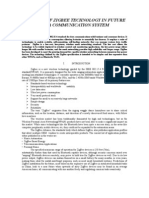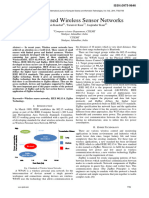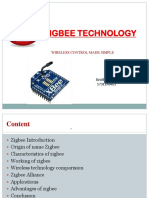Seminar Report
On
Zigbee
Submitted To:
Mrs. Ritu Miss Rajni
Submitted By:
Parvesh Kumar 1505176 Ec3 (8th Semester)
�INDEX
Introduction History of ZigBee About ZigBee Where it operates What does ZigBee do How it works Example of how Zigbee Works Types of Zigbee Modes of ZigBee ZigBee vs. Bluetooth Uses of ZigBee References 3 4 5 6-7 8-9 10 11 12-13 14 15 16 17
Introduction
2
�Zigbee is a rather new wireless technology that looks to have applications in a variety of fields. Zigbee is a technological standard based on the IEEE 802.15.4 specification for low data rates technology allows for devices to communicate with one another with very low power consumption, allowing the devices to run on simple batteries for several years. ZigBee is designed for wireless control and sensors. It could be built into just about anything you have around your home or office, including lights, switches doors and appliances. These devices can then interact without wires and you can control them all . . . from a remote control or even your mobile phone. Although ZigBee's underlying radiocommunication technology isn't revolutionary, it goes well beyond single-purpose wireless devices, such as garage door openers and "The Clapper" that turns light on and off. It allows wireless two-way communications between lights and switches, thermostats and furnaces, hotel-room air-conditioners and the front desk, and central command posts. It travels across greater distances and handles many sensors that can be linked to perform different tasks.
History of Zigbee
3
�Incidentally, the term ZigBee originates from the silent, but powerful method of communication used by honeybees to report information about food sources. This communication system is known as the ZigBee Principle"[1]. By flying around in a zig-zag pattern, a bee is able to share critical information, such as the location, distance, and direction of a newly discovered food source to its fellow hive members. The protocols build on recent algorithmic research to automatically construct a low-speed ad-hoc network of nodes. In most large cases, the network is a cluster of clusters. It can also form a mesh or a single cluster. The ZigBee protocols support both beaconing and non-beaconing networks. In beaconing networks, the network nodes transmit beacons to confirm their presence to other network nodes, and to allow nodes to sleep between beacons, thereby lowering their duty cycle and extending their battery life. Beacon intervals may range.
About Zigbee
4
�ZigBee is the name of a specification for a suite of high level communication protocols using small, low-power digital radios based on the IEEE 802.15.4-2006 standard for wireless personal area networks (WPANs), such as wireless headphones connecting with cell phones via short-range radio. The technology is intended to be simpler and cheaper than other WPANs, such as Bluetooth. ZigBee is targeted at radio-frequency (RF) applications that require a low data rate, long battery life, and secure networking. The ZigBee Alliance, the standards body which defines ZigBee,[2] also publishes application profiles that allow multiple OEM vendors to create interoperable products. The current list of application profiles either published or in the works are: Home Automation ZigBee Smart Energy Telecommunication Applications Personal Home Hospital Care
�Where It Operates
A concern that could arise may be related to the specific frequency band that ZigBee uses - that is, the 2.4 GHz band, which is the same band used by IEEE 802.11 and Wi-Fi. A cursory reading of the previous sentence may seem to imply that ZigBee could not co-exist with these other technologies without interfering with one another. However, ZigBeebased products can access up to 16 different 5 MHz channels within the 2.4 GHz band, several of which do not overlap those of 802.11 and Wi-Fi; data packets are automatically retransmitted in case interference does happen to occur; and very few data packets are transmitted anyway, further reducing the probability that data will be lost. Thus, ZigBee, with its specific application focus, is not generally affected by other similar wireless technologies
A Comparison Of Data Sending Speed Between Various Wireless Technologies
6
The data rate is limited to 250 kbps
What Does Zigbee Do
7
�ZigBee is designed for wireless controls and sensors. It could be built into just about anything you have around your home or office, including lights, switches, doors and appliances. These devices can then interact without wires, and you can control them all . . . from a remote control or even your mobile phone. ZigBee works well because it aims low. Controls and sensors don't need to send and receive much data. ZigBee has been designed to transmit slowly. It has a data rate of 250kbps (kilobits per second), pitiful compared with Wi-Fi, which is hitting throughput of 20Mbps or more. But because ZigBee transmits slowly, it doesn't need much power, so batteries will last up to 10 years. Because ZigBee consumes very little power, a sensor and transmitter that reports whether a door is open or closed, for example, can run for up to five years on a single double-A battery. Also, operators are much happier about adding ZigBee to their phones than faster technologies such as Wi-Fi; therefore, the phone will be able to act as a remote control for all the ZigBee devices it encounters.
A Figure Shows How Zigbee Controls Your Home Devices
�How Zigbee Works
9
�ZigBee basically uses digital radios to allow devices to communicate with one another. A typical ZigBee network consists of several types of devices. A network coordinator is a device that sets up the network, is aware of all the nodes within its network, and manages both the information about each node as well as the information that is being transmitted/received within the network. Every ZigBee network must contain a network coordinator. Other Full Function Devices (FFD's) may be found in the network, and these devices support all of the 802.15.4 functions. They can serve as network coordinators, network routers, or as devices that interact with the physical world. The final device found in these networks is the Reduced Function Device (RFD), which usually only serve as devices that interact with the physical world.
10
�Example of How Zigbee Works
Network coordinator ZC
ZR-1
ZR-2
ZR-3
RFD RFD-1 RFD-2 -3
11
�There are four different types of ZigBee devices:
ZigBee coordinator(ZC): The most capable device, the coordinator forms the root of the network tree and might bridge to other networks. There is exactly one ZigBee coordinator in each network since it is the device that started the network originally. It is able to store information about the network, including acting as the Trust Centre & repository for security keys. ZigBee Router (ZR): As well as running an application function a router can act as an intermediate router, passing data from other devices. ZigBee End Device (ZED): Contains just enough functionality to talk to the parent node (either the coordinator or a router); it cannot relay data from other devices. This relationship allows the node to be asleep a significant amount of the time thereby giving long battery life. A ZED requires the least amount of memory, and therefore can be less expensive to manufacture than a ZR or ZC. Zigbee Device Object (ZDO): A special device in a Zigbee network responsible for a number of tasks, which include keeping of device roles, management of requests to join a network, device discovery and security.
12
�Figure Shows How Signal Passes Through Routers
Modes of Zigbee
13
�ZigBee operates in two main modes: Beacon mode is a fully coordinated mode in that all the device know when to coordinate with one another. In this mode, the network coordinator will periodically "wake-up" and send out a beacon to the devices within its network. This beacon subsequently wakes up each device, who must determine if it has any message to receive. If not, the device returns to sleep, as will the network coordinator, once its job is complete. Non-beacon mode, on the other hand, is less coordinated, as any device can communicate with the coordinator at will. However, this operation can cause different devices within the network to interfere with one another, and the coordinator must always be awake to listen for signals, thus requiring more power. In any case, ZigBee obtains its overall low power consumption because the majority of network devices are able to remain inactive over long periods of time.
14
�Zigbee Vs Bluetooth
ZigBee is broadly categorized as a low rate WPAN, and its closest technology is Bluetooth. A good bit of energy has been spent in analyzing whether ZigBee and Bluetooth are complementary or competing technologies. 1. They are two different technologies with very different areas of application and different means of designing for those applications. While ZigBee is focused on control and automation, Bluetooth is focused on connectivity between laptops, PDAs, and the like, as well as more general cable replacement 2. ZigBee uses low data rate, low power consumption, and works with small packet devices; Bluetooth uses a higher data rate, higher power consumption, and works with large packet devices. ZigBee networks can support a larger number of devices and a longer range between devices than Bluetooth. 3. Bluetooth must rely on fairly frequent battery recharging, while the whole goal of ZigBee is for a user to be able to put a couple of batteries in the devices and forget about them for months to years. In timing critical applications. 4. ZigBee is designed to respond quickly, while Bluetooth takes much longer and could be detrimental to the application. Thus, a user could easily use both technologies as a wireless solution in a PAN to suit all types of applications within that network.
Uses of Zigbee
15
Home Entertainment and Control Smart lighting, advanced temperature control, safety and security, movies and music. Home Awareness Water sensors, power sensors, smoke and fire detectors, smart appliances and access sensors. Mobile Services m-payment, m-monitoring and control, msecurity and access control, m-healthcare and tele-assist. Commercial Building Energy monitoring, HVAC, lighting, access control. Industrial Plant Process control, asset management, environmental management, energy management, industrial device control.
References
16
�www.google.com 2. www.wikkypedia.com 3. Yahoo search
1.
17

















































































